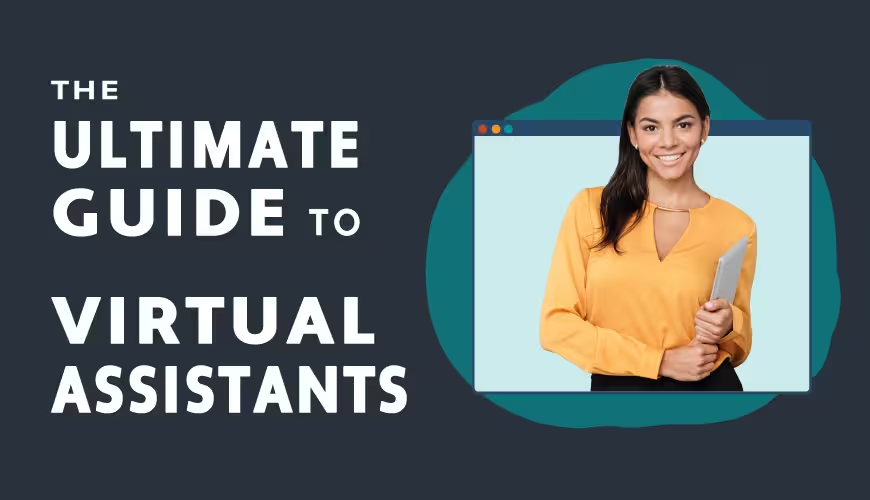Virtual assistants were first introduced to the business world in 2009 by Tim Ferriss, author of “The 4-Hour Work Week.” Ferriss showed readers how to work less by outsourcing repetitive or unpleasant tasks to an offshore contractor at a lower hourly rate, allowing them to spend more time on higher-value work and engaging in activities they care about most, such as travel and adventure.
The concept gained popularity, resulting in a surge of virtual assistant businesses and freelancers offering services, so many that choosing the right model and individual can feel overwhelming.
It makes sense. The average entrepreneur spends more than a third of their workweek on small administrative tasks that divert their attention from their core focus.
There are various ways to hire virtual assistants, whether onshore or offshore. This guide will help you navigate the options and find the best solution for your business.
Table of Contents:
A virtual assistant (VA) serves as a remote administrative support for executives, managers, and teams, and is sometimes referred to as a virtual executive assistant—although the two roles are not always interchangeable. The word "virtual" can be misleading because it suggests something that isn't tangible or real. Still, virtual assistants are real people who offer genuine support to executives from distant locations.
Virtual assistant services evolved from traditional business process outsourcing, offering the advantages of outsourcing but a white-glove experience that's closer to having a full-time in-house employee.
Advances in high-speed internet, remote work systems that can be accessed from anywhere, and communication tools like chat channels and video conferencing make it easy for executives to hire full-time or fractional virtual assistants without office space and employment-related overhead.
Want to learn more about how a VA can help your business? We'd be happy to talk you through it!
Why You Need a Virtual Assistant
It's time to consider hiring a virtual assistant if you're not hitting your business goals because you're spending too much time on daily tasks, leaving less time for strategic planning. Many business owners and entrepreneurs tend to do everything themselves, thinking they are saving money. While this approach is understandable, it often causes responsibilities to be overlooked, increases burnout, and diverts focus from what truly matters.
Eventually, as the business grows, they reach a point where growth stalls because they can't keep up with the executive functions of their business or department.
Signs you need a virtual assistant
- Sales start to plateau
- Your work-life balance teeters toward work
- Customers complain about poor service
- You're not following up with sales leads fast enough
- Employees are leaving
- Sales, customer, and financial data are in disarray
- You're falling behind on invoicing
All of these signs suggest that you're not dedicating enough time to advancing your business. Customers, employees, and family members aren't receiving the attention they deserve. When you reach the stage where you're not invoicing and receiving payments, you're in trouble. And that means, it might be time to hire a virtual assistant.
What Can a Virtual Assistant Do?
The types of work that a virtual assistant does include:
- Executive administration (like calendaring and email management)
- Sales and marketing support
- Back-office operations
- Personal life rasks
- Specialized skills
Let's look at the specific tasks virtual assistants can perform in each category.
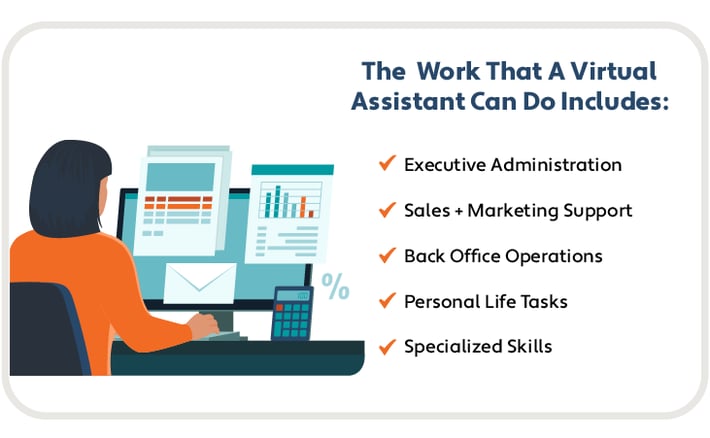
Explore 26 virtual assistant tasks and duties you can outsource
Executive Administration
Executives often spend 16 hours each week on routine tasks that take away from activities that drive their businesses forward. This makes up 40% of their week focused on administrative work.
Where does all this time go?
Examples of the time executives spend on admin tasks include:
- 3 hours a day on email
- 23 minutes to schedule each meeting
- 12 hours dedicated to planning every business trip
Additionally, there's the cost of context switching—the time it takes to switch from the email you're writing to reporting, then back to your calendar, into a meeting, and back to email. You can't immediately pick up new tasks. Every time, you lose a few minutes and some focus.
So, what do virtual assistants do? They help you minimize the need for frequent context switching. They handle those outward-facing front office tasks that take up a large part of your time. These are the traditional tasks you hire a virtual assistant for.
General admin tasks include:
- Scheduling meetings & calendar management
- Fielding phone calls and emails
- Placing phone calls and sending emails
- Organizing inboxes and consolidating calendars
- Planning travel arrangements and events
- Filing expense reports
- Reaching out to your professional network
- Preparing and maintaining templated documents
- General data entry
For instance, when you're traveling, your virtual assistant can set up meetings with key contacts in the area. They can also stay on top of your preferences (or those of your contacts) for meeting spots and times.
Professionals who use virtual assistants for these tasks include:
- Executives like venture capitalists who meet with investors
- Sales executives who schedule sales calls
- HR executives scheduling job interviews
- Real estate professionals who meet with buyers and sellers
Sales and Marketing Support
Using a virtual assistant for sales and marketing is an excellent example of how VAs can benefit specific teams! Both teams often get bogged down with tedious tasks that can hinder their success.
Multiple studies show salespeople spend just 11%-36% of their time selling, while most of their time is spent on non-sales tasks. (Insidesales.com: 36% Proudfoot Consulting Group: 11% Pace Productivity: 22% Salesforce: 30%)
This indicates that, regardless of the company, your sales teams likely spend less than half of their time selling. This is far from ideal.
Where does the time go?
According to Pace, a sales leader's time allocation in a typical week looks like this:
- Admin and paperwork: 7.3 hours
- Email management and correspondence: 8.2 hours
- Internal communication: 6.6 hours
- CRM Management: 2.2 hours
A sales virtual assistant can alleviate much of this workload for a sales leader, allowing them to spend more time with customers and prospects.
Virtual assistant tasks unique to sales include:
- CRM data entry and management
- Customer and lead research and targeting
- Leader generation
- Social media communication
- Prospecting
- Following up on sales leads
- Managing email campaigns
Marketing teams often feel overwhelmed by routine administrative tasks, such as managing vendor communications, maintaining social media calendars, sending emails, organizing data, and generating reports. A HubSpot survey reveals that they spend an average of 16 hours each week on day-to-day administrative work.
A virtual marketing assistant can help:
- Manage email campaigns
- Schedule social posting
- Monitor inboxes
- Update sales enablement and marketing materials
- Track tasks and deadlines
- Update routine reporting
- Assist with technical SEO tasks
- Respond to comments, messages, and website chats
- Coordinate with remote teams
- Schedule lead follow-up and cadences
- Update customer data for accuracy
If your sales or marketing teams have routine, repeatable tasks that are eating up their time, a virtual assistant might be just the solution they need.
Back-office Operations
Back-office tasks are the essential, time-consuming tasks that take place behind the scenes to support your business's infrastructure and systems.
For example, executives spend:
- 8 hours a week creating templated documents like proposals, contracts, and sales sheets
- 7 hours a month entering data in bookkeeping programs
- 20 days a year pursuing overdue payments
Back-office work is important but often overlooked. Hiring a VA focused on delivering the right documents to customers, maintaining accurate books, and following up on overdue invoices can significantly improve profits.
Back-office operations impact cash flow, compliance, hiring capacity, customer onboarding, and other key areas. Due to the behind-the-scenes nature of this work, it's all too easy to lag.
Back-office tasks that a virtual assistant performs include:
- Data entry and cleanup
- Light bookkeeping
- Invoicing and billing
- Payment processing
- Collections
- Generate reports
- HR record keeping
- Compliance documentation
CRM management could also be considered a back—office operation, especially regarding forecasting, supply chain management, and inventory control.
Personal Life Tasks
Executives spend up to 25% of their work time on personal activities, and the rise of remote work has further blurred the line between personal and professional tasks.
Examples of personal tasks a virtual assistant can tackle include:
- Calendar management
- Planning vacation travel
- Scheduling fitness classes
- Scheduling medical and personal appointments
- Sending gifts and ordering flowers
- Making online purchases
- Paying bills
Specialized Skills
Another way businesses use virtual assistants is for specialized skills that are needed on either an occasional or ongoing basis. These skills often go beyond what a traditional administrative assistant typically offers; therefore, these roles require thorough training and development. In this case, you would want to hire a virtual assistant whose main focus is your specialized work.
Examples of specialized virtual assistant skills include:
- Graphic design
- Web design and development
- Accounting
- Content writing
- Search engine optimization
- Project management
Some virtual assistants may have experience in one or more of these areas, but they will also have to develop a nuanced understanding of your business and message.
Learn more: 26 tasks you can outsource to a virtual assistant
How Much Does Hiring a Virtual Assistant Cost?
The short answer to how much a virtual assistant will cost is, "It depends."
The cost of hiring a virtual assistant will depend on:
- The kind of work you need
- The type of relationship you want
- The level of quality control you desire
- The daily training and management you're willing to handle
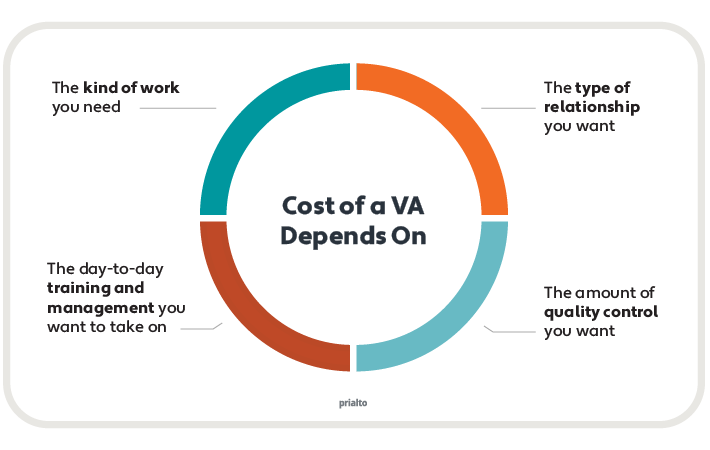
There are three main ways to hire a virtual assistant:
- Hiring a freelancer directly or through a marketplace
- Contract virtual assistant agencies
- Hiring a managed virtual assistant service
The Cost of a Freelance Virtual Assistant
You can hire a freelance virtual assistant through a marketplace like Upwork or a job board like Indeed.com or Craigslist. Upwork offers virtual assistants starting at $10 per hour, while assistants on other job boards generally begin around $20. A freelancer is usually the most affordable option.
A freelance virtual assistant can work if:
- The kind of work you need is short-term and project-based
- The relationship you want to have is sporadic and transactional
- You want to be directly responsible for quality control
- You're up for taking on day-to-day training and management
- You're looking for specialized skills beyond the traditional virtual assistant role
Of course, there are some risks associated with this approach. You don't bring them onto your team, so you have a lot less control.
The Cost of a Contract Virtual Assistant Agency
Contract virtual assistant agencies maintain a pool of vetted virtual assistants you can select from. Many are looking for long-term jobs and offer bulk pricing with monthly retainers. Prices vary widely by location—U.S.-based agencies charge between $30 and over $100 an hour. Agencies that connect you with offshore assistants usually start at around $20 an hour.
A contracting agency works if:
- The kind of work you need is ongoing admin support
- You are willing to work at building a productive relationship
- You want to be responsible for quality control
- You are ready to take on day-to-day training and management
Most agencies act as matchmakers. There is limited hands-on support for establishing the relationship and ensuring quality control. Furthermore, not all agencies specialize in virtual assistants; some offer additional services, such as accounting, web design, and graphic design.
The Cost of a Managed Virtual Assistant Service Provider
Managed virtual assistant service providers hire, train, and optimize the performance of virtual assistants for you. The assistants are employees of the service providers.
Prices typically range from $20 to $30 per hour and include more than just an assistant's time. Managed virtual assistance services can include access to an account manager, backup support, a personalized approach, access to best practices and training, and comprehensive documentation. These services are designed to handle the management aspect, so you don't have to.
Think of it this way. Typically, a managed virtual assistant service provides you with access to an entire support team. A freelancer or agency only gives you a single point of support.
A managed virtual assistant service works if:
- The kind of work needed is executive admin, sales, or back-office support
- You want a white-glove service that trains assistants on your tools and systems
- You want a guaranteed service level
- You don't want more people to manage
Account managers work with you to document processes and train virtual assistants on client systems before the engagement starts. This ensures the assistants are prepared to contribute right from the beginning. The account manager then provides client feedback and coaches the assistant to support their work.
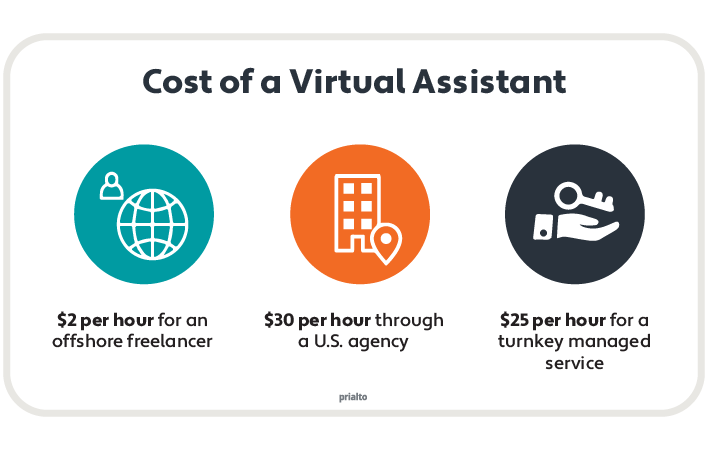
To summarize, the cost of a virtual assistant starts at:
- $2 per hour for an offshore freelancer
- $30+ through a U.S. agency
- Around $25 per hour for a turnkey managed service
Learn more: The ROI of a virtual assistant
How to Hire a Virtual Assistant
How you hire the right virtual assistant for your business is very closely related to the cost and business model that best suits you. Each has its risks and benefits.
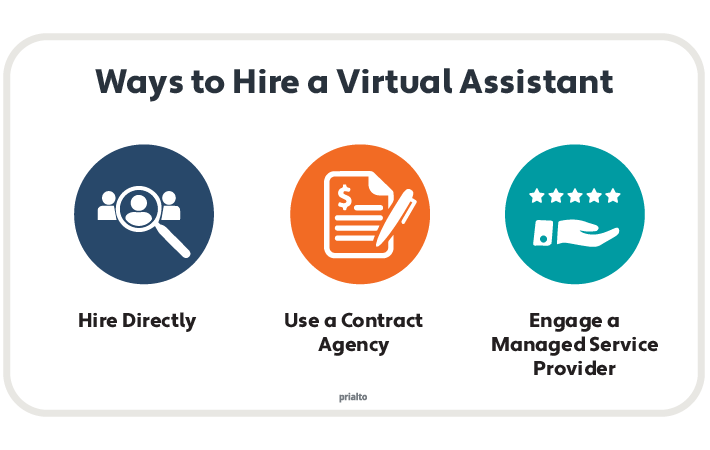
Directly Hire a Freelance Virtual Assistant
As mentioned above, if you're looking to hire a freelancer, you can find a virtual assistant directly through a job board or marketplace. The trade-off is simple. When you hire a freelance virtual assistant, you're spending less money but more time and effort managing them.
If you're looking for a local virtual assistant—someone you can meet in person who can handle local tasks such as deliveries and errands—you might find a freelancer in your area.
The disadvantages of directly hiring freelance virtual assistants are time and risk.
- You have to spend time recruiting, interviewing, and vetting candidates
- Investing in training, project management, and performance management is essential.
- The overhead of payroll and any legal compliance with the home country (of offshore assistants)
- If the virtual assistant doesn't work out, you start over
- Lack of control of data, device, and network security
- You might need to buy software for your virtual assistant
- It can be challenging to find someone with solid virtual assistant skills
- Freelancers usually have several clients so that availability may be a factor
You must also know the exact skills and experience you're looking for and create a job description for a virtual assistant to attract suitable candidates. Defining job requirements can be challenging when looking for your first assistant.
Hire a Contract Virtual Assistant through an Agency
Hiring a virtual assistant through a contract agency saves you time on recruiting and vetting candidates. Additionally, you typically pay the agency in US dollars and avoid dealing with compliance issues if the virtual assistants are offshore.
The disadvantages of hiring a virtual assistant through an agency are:
- You take on any training, project management, and performance management
- If the virtual assistant doesn't work out, you start over
- Most contractors work from home offices with personal computers, so IT security can pose a risk. Hirees must ensure that assistants use security tools, such as password managers and VPNs, to safeguard sensitive data.
- Contactors often have multiple clients, so availability may be an issue
- If the agency does not specialize in virtual assistants, it may not be able to help you find what you need
Hire a Managed Virtual Assistant Service Provider
With a managed virtual assistant service, you hire the service provider, not an individual assistant. You receive a team—including an account manager, a virtual assistant, backup managers, and assistants. Managed virtual assistant services typically start at around $25 per hour.
The main benefit of this model is that all recruiting, vetting, hiring, training, and performance management are taken off your plate, along with most of the risks associated with hiring freelancers and contractors.
- You can hire faster
- You have an experienced partner in helping you leverage a virtual assistant
- You get a virtual assistant pre-trained on your processes and tools
- An account manager documents your operations and enables you to offload more tasks
- The account manager provides ongoing process optimization
- Backup assistants mean you never start over
- Assistants undergo background checks and have secure facilities, networks, and computers
This model works well for both small business leaders and enterprise teams, but it may not be suitable for everyone.
The disadvantages of managed virtual assistant services are:
- Services come in packages with set monthly hours
- It will not be the cheapest option
- Works best with repetitive processes, not so much with creative work like web and graphic design that requires artistic judgment
Managed virtual assistant service providers bear most of the risk in hiring virtual assistants. The service provider employs assistants, pays them, and provides benefits and opportunities for growth.
This model also attracts businesses concerned about how providers treat offshore assistants, including their working conditions.
Additional Resources: What you need to know about virtual assistant security
How Do You Manage a VA?
Remote virtual assistants are categorized into two broad types: managed and unmanaged services.
- In an unmanaged service, you hire a freelance assistant or a contractor through an agency. You engage, onboard, train, and manage the virtual assistant's performance.
- In a managed service, assistants are hired, trained, overseen, and paid by the service provider.
Unmanaged Assistants
With unmanaged virtual assistants, you need to know what you want the assistant to do and how you want it done. Defining what you want is often a challenge for business executives who have many of their processes in their heads. They tend to have difficulty delegating those processes to others.
The lift required by other responsibilities, such as payroll, HR paperwork, performance reviews, and giving and receiving feedback, will depend on the hiring model.
Contract agencies often handle some of that, but with freelancers, those responsibilities will be on you. You must also consider the IT security risks associated with the virtual assistant's computer and network. Managing a virtual assistant requires clear communication, well-defined tasks, and tools that track their work.
Managed Services
The main benefit of a managed virtual assistant service is that the management portion is off your plate.
The service provider:
- Hires the assistants
- Documents your processes, tools, and preferences
- Trains the assistant on those processes
- Onboards the assistant for you
- Manages performance
- Provides backup assistants
For individuals who prefer not to manage another employee or invest time in training and onboarding a virtual assistant, this model is ideal. It also offers scalability—adding more assistants as needed is easy, usually by using pre-trained backups.
The IT security issue previously mentioned is also addressed—the managed service provider conducts background checks and provides secure computers, networks, and facilities.
Managed VA services typically work on a monthly retainer, where you pay for a certain number of monthly hours. They are not ideal for occasional projects, such as quarterly reports or creative projects that require fresh design, writing, or graphic design-intensive work.
Hire Virtual Assistants to Provide Productivity and Efficiency
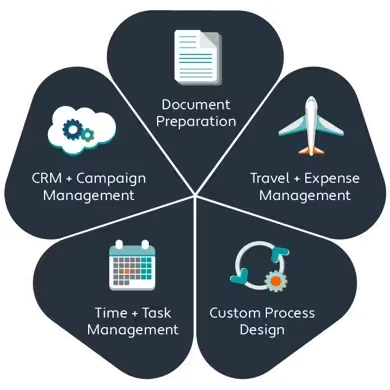
If your business growth is limited by the time you can dedicate to it, you should consider hiring a virtual assistant.
Virtual assistants can be a cost-effective way to accomplish this. They can boost productivity by giving you and your team more time and efficiency, allowing greater focus on growth. (Not to mention the many other benefits of hiring a VA.)
With around 25,000 virtual assistant services available, choosing the right assistant and service model can be overwhelming!
Use this guide to narrow down the options by defining the kind of work want to offload, the relationship you want to have with your assistant, the amount of management you want to take on, and, of course, the price you want to pay.
Ready to hire a virtual assistant you don't have to manage?
